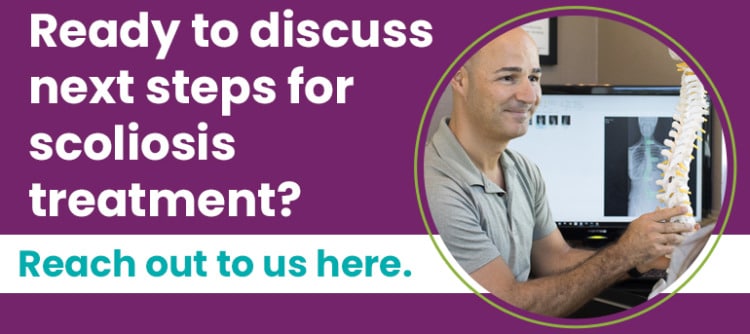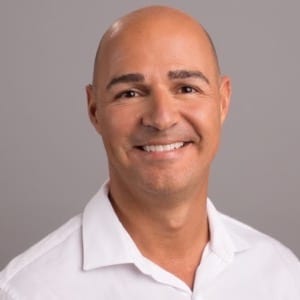Adolescent Idiopathic Scoliosis: Causes and Treatments
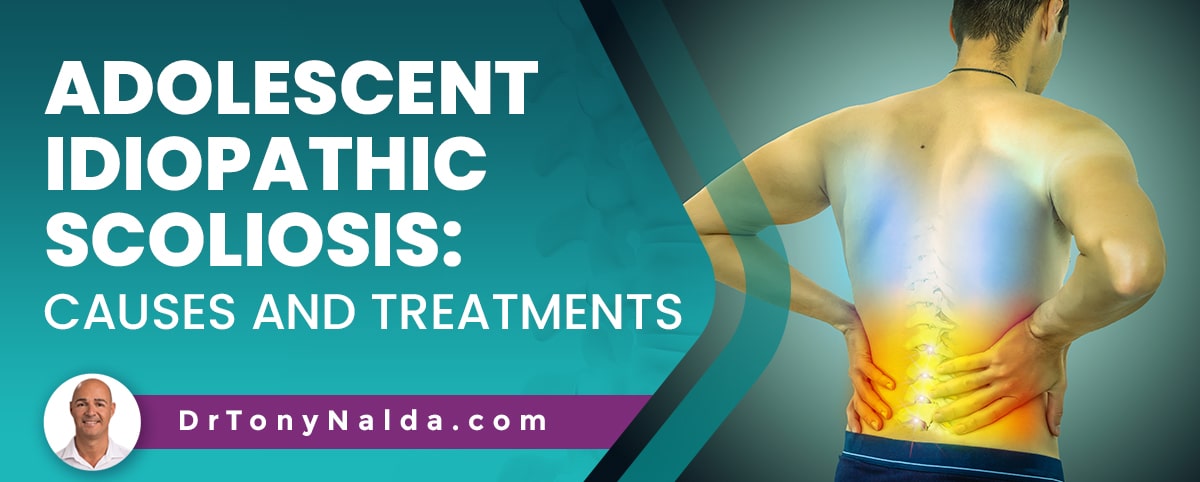
There are different types of scoliosis, and type is determined by a condition's underlying cause. Approximately 80 percent of known cases are idiopathic, having no known cause, and the remaining 20 percent are associated with known causes: neuromuscular scoliosis, degenerative scoliosis, and congenital scoliosis.
The most common type of scoliosis to affect all ages is idiopathic scoliosis, and the most prevalent type of scoliosis overall is adolescent idiopathic scoliosis diagnosed between 10 years of age and reaching skeletal maturity.
Adolescents are the most at risk for rapid progression, and this is due to the rapid and unpredictable growth spurts of puberty.
Table of Contents
What is Adolescent Idiopathic Scoliosis?
Scoliosis Research Society has current estimates at close to seven million people living with scoliosis in the United States alone, and scoliosis is the most common spinal deformity among school-aged children.
Adolescent idiopathic scoliosis is the condition's most-prevalent type; the condition is diagnosed in children between 10 years old and reaching adulthood; once skeletal maturity has been reached, adult scoliosis is diagnosed.
Scoliosis causes the development of an abnormal spinal curve that bends to the side and twists, making it a complex 3-dimensional condition that becomes more complex to treat, particularly if left untreated, or not treated proactively.
While we don't know what causes the initial development of idiopathic scoliosis in adolescence, we know it's growth that makes it progress, and the rapid growth spurts of puberty make patients vulnerable to rapid-phase progression.
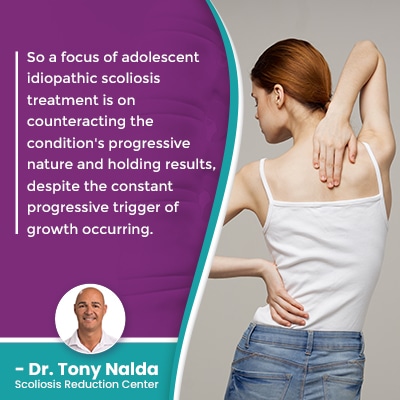 So a focus of adolescent idiopathic scoliosis treatment is on counteracting the condition's progressive nature and holding results, despite the constant progressive trigger of growth occurring.
So a focus of adolescent idiopathic scoliosis treatment is on counteracting the condition's progressive nature and holding results, despite the constant progressive trigger of growth occurring.
And what happens as scoliosis progresses?
Progression
As scoliosis progresses, the size of the unnatural spinal curve is increasing, and this is introducing more uneven forces to the body, and the condition's effects become more pronounced.
As scoliosis progresses, the spine is becoming increasingly rigid, making it more difficult to treat as the spine is less easily adjusted.
Part of non-surgical treatment involves physical therapy and scoliosis exercises, and patients who have experienced a lot of progression can find it difficult to perform scoliosis-specific exercises that are part of treatment.
In fact, in many cases of adult scoliosis, some preparatory work has to be done before starting the regular course of treatment to first establish a baseline level of spinal flexibility.
Progression makes the condition more severe, and condition severity ranges from mild scoliosis to moderate, severe and very severe cases.
As progression occurs, the condition's effect become more severe and noticeable; this is why most of my patients are diagnosed with moderate scoliosis; it can be difficult to detect the early signs of mild scoliosis because they can be mild and subtle.
So what are the main signs of adolescent idiopathic scoliosis to look out for?
Symptoms of Adolescent Idiopathic Scoliosis and Early Detection
There are no treatment guarantees, but with early detection and intervention, there are fewer limits to what non-surgical treatment can achieve.
Diagnosing adolescent idiopathic scoliosis early means that treatment can be started early, prior to significant progression occurring, and when conditions are most likely to respond well to treatment.
When scoliosis is mild, the curve is small and malleable, making correction more likely.
The main effects adolescent idiopathic scoliosis involve postural changes, and knowing the condition's early signs can make early detection and intervention possible.
Postural changes associated with scoliosis in adolescents can include:
- Uneven shoulders
- Uneven shoulder blade protruding more on one side
- Development of a rib hump
- Uneven hips
- Arms and legs hanging at different lengths
As a result of postural changes, clothing can seem suddenly ill-fitting, and changes to gait, balance, and coordination are also common.
While pain is the main symptom of adult scoliosis, it's not considered a common effect of adolescent idiopathic scoliosis.
Adolescent Idiopathic Scoliosis and Pain
A common effects of adult scoliosis is pain, but childhood scoliosis isn't known as painful, and this is because scoliosis doesn't become a compressive condition until skeletal maturity has been reached.
Growing spines are constantly experiencing a lengthening motion that counteracts the compressive force of the unnatural spinal curvature, but adult spines are more rigid and vulnerable to compression.
Scoliosis pain can involve the muscles, back pain, and pain that radiates into the extremities due to nerve compression.
Adolescents and children can experience varying degrees of muscle pain, and the more severe a condition, the more overt its effects, including pain, are likely to be.
Scoliosis curves introduce uneven forces that can affect the spine, its surroundings, and the entire body.
Adolescent Idiopathic Scoliosis Treatment
Adolescent idiopathic scoliosis needs to be treated proactively; as a progressive condition, when treatment is started is key.
So immediately following a diagnosis of adolescent idiopathic scoliosis is when it's the mildest and most likely to respond well to treatment, and a proactive treatment approach will be started as close to the time of diagnosis as possible.
While surgery can address scoliosis, non-surgical treatment success proves that not all cases of scoliosis require surgical intervention.
Conservative scoliosis treatment is integrative; no one treatment discipline on its own is enough to impact scoliosis on multiple levels the ways it needs to be.
When multiple scoliosis-specific treatment disciplines are combined and customized to address an individual's condition type, curve progression can be managed, and scoliosis can be highly treatable.
Chiropractic Care: Curvature Reduction
The main impact of treatment has to be on a structural level; the underlying nature of scoliosis is structural.
To impact scoliosis structurally means addressing the structural abnormality within the spine itself, and this is worked towards through a number of chiropractic techniques and manual adjustments with the goal of reducing curve magnitude and progression.
Adjusting the position of the curve's most-tilted vertebrae so they are more aligned with the rest of the spine means reducing the size of the unnatural spinal curve.
Chiropractic care can achieve changes within the spine, but these changes have to be supported, and this is another key facet of scoliosis treatment: strengthening the spine's surrounding muscles.
Physical Therapy and Scoliosis Exercises: Core Strengthening
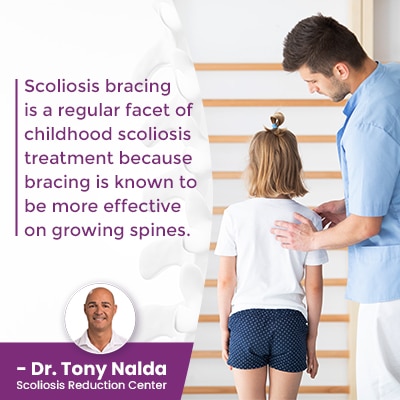 It's not just the spine that maintains its natural curves and alignment; it's also the role of the spine's surrounding muscles to support and stabilize the spine.
It's not just the spine that maintains its natural curves and alignment; it's also the role of the spine's surrounding muscles to support and stabilize the spine.
When scoliosis-specific, physical therapy and exercises can help balance and strengthen the spine's surrounding muscles.
Scoliosis progression is also associated with a muscular imbalance; an unnaturally-curved spine can pull its surrounding muscles in different directions, and muscles on one side of the spine can become weak from underuse while muscles on the other side can become strained from overuse.
A spine needs support from its surrounding muscles.
Corrective Bracing: Corrective Results
Scoliosis bracing is a regular facet of childhood scoliosis treatment because bracing is known to be more effective on growing spines.
A corrective ScoliBrace can help correct scoliosis by pushing the spine into a straighter alignment, and when combined with other types of conservative treatment, scoliosi can be impacted on every level, without risking surgical complications.
Rehabilitation: Holding Results
As a progressive condition, there is no curing scoliosis, but it can be highly treatable.
Scoliosis treatment is about how to manage an ongoing condition for the best quality of life, and this can involve continued chiropractic care, lifestyle guidance, and the prescription of custom-designed scoliosis exercises; patients perform these exercises from home to further health/stabilize the spine.
Conclusion
While we don't know the cause of adolescent scoliosis, we know it's growth that makes it get worse, and we know that adolescents are the most at risk for rapid progression.
Scoliosis is commonly diagnosed in adolescents due to postural and movement changes, a physical examination, an adam's forward bend test, and X-ray results confirming the spine's rotation and Cobb angle measurement.
A patient's Cobb angle is a key measurement that condition severity is based on and treatment plans are shaped around.
Untreated idiopathic scoliosis can progress unimpeded, and untreated adolescent scoliosis can progress quickly, becoming more complex to treat, and leading to a surgical recommendation in the future.
Predicting scoliosis progression is based on how much growth and adolescent has left to go through, and an adolescent girl is likely to progress more than a male of the same age; this is understood, in part, due to the earlier start of puberty in females, and changes in hormones.
While mandatory scoliosis screening used to happen across the United States, that has since changed, shifting the onus of early detection onto the shoulders of parents, caregivers, and patients themselves.
Knowing the condition's early signs to watch for in adolescents can help lead to early detection, intervention, and treatment success.
Here at the Scoliosis Reduction Center®, treatment results speak for themselves, and most young typical scoliosis patients can experience condition improvement without facing the risks of spinal fusion surgery.
Dr. Tony Nalda
DOCTOR OF CHIROPRACTIC
After receiving an undergraduate degree in psychology and his Doctorate of Chiropractic from Life University, Dr. Nalda settled in Celebration, Florida and proceeded to build one of Central Florida’s most successful chiropractic clinics.
His experience with patients suffering from scoliosis, and the confusion and frustration they faced, led him to seek a specialty in scoliosis care. In 2006 he completed his Intensive Care Certification from CLEAR Institute, a leading scoliosis educational and certification center.
About Dr. Tony Nalda
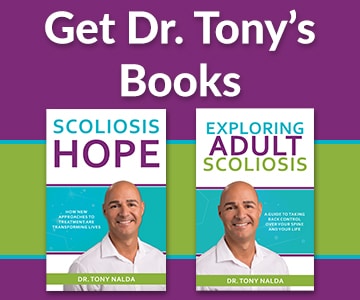 Ready to explore scoliosis treatment? Contact Us Now
Ready to explore scoliosis treatment? Contact Us Now